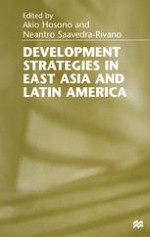1998 | OriginalPaper | Chapter
Export-led Economic Development: the Malaysian Model
Authors : Mohamed Ariff, Mahani Zainal-Abidin
Published in: Development Strategies in East Asia and Latin America
Publisher: Palgrave Macmillan UK
Included in: Professional Book Archive
Activate our intelligent search to find suitable subject content or patents.
Select sections of text to find matching patents with Artificial Intelligence. powered by
Select sections of text to find additional relevant content using AI-assisted search. powered by
Malaysia, despite its small size, stands tall in the community of developing nations. Its per capita income has increased ten fold from US$ 334 in 1970 to US$ 3275 in 1993 (see Table 10.1), and it has joined the league of Advanced Developing Countries and Newly Industrialized Economies (NIEs). Its economy is marching confidently towards developed country status targeted for the year 2020, and it is clearly within striking distance of this. Malaysia’s economic performance since independence in 1957 has been very impressive, both in quantitative and qualitative terms. It has been growing at a rapid pace, an average of over 6.7 per cent per annum for 37 years and over eight per cent during the last seven years. These high growth rates have been accompanied by high labour absorption, equitable income distribution and low inflation. Income distribution has improved marginally within and between racial groups. More significant is the success of the poverty eradication programme: the incidence of poverty1 has declined from 49 per cent in 1970 to 15 per cent in 1990. In addition, crude death and infant mortality rates have declined sharply, while life expectancy has risen significantly.
